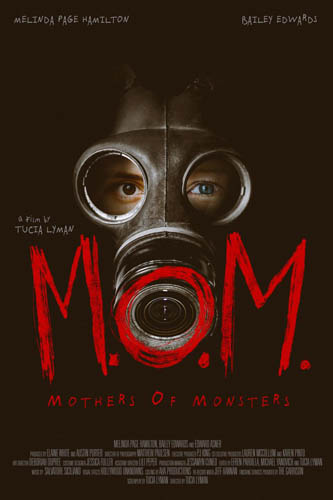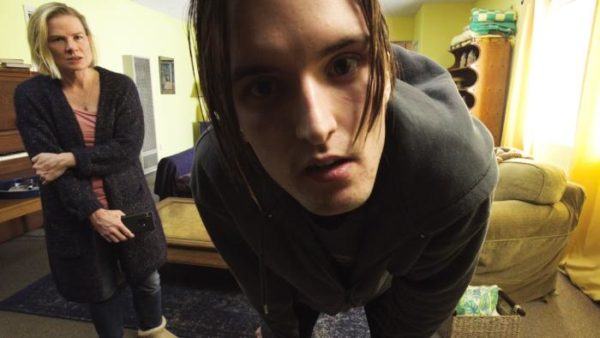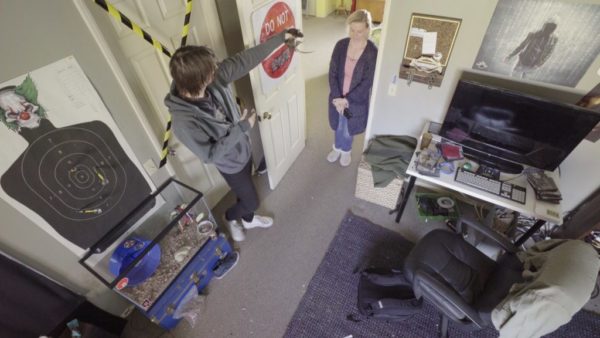M.O.M Mothers of Monsters (2020)
Starring: Bailey Edwards, Melinda Page Hamilton

M.O.M. Mothers of Monsters
Directed by Tucia Lyman
It was twenty minutes or so into this film that I realised who leading lady Melinda Page Hamilton reminded me off: Lionel Shriver. Which is a nice coincidence given her novel, We Need To Talk About Kevin, was the basis for another film about school shooters. Only while it dealt with the fallout, this one is about a single mother, named Abbey, worrying her son may go that same way. All the early warning signs are there and, in a bit of nature vs nurture baiting backing story, many years back, her big brother killed several kids. She has reached out before, but nobody listened, so she has begun obsessively filming everything her flesh and blood does. So there’s a pretty cool dilemma at this film’s core – how do you protect your kid from the monster when the monster is him? M.O.M asks at what point it becomes ok to believe your flesh and blood is capable of doing terrible things. Given her family history, Abbey’s understandably torn between two drives: stopping history repeating itself and seeing the best in her son.
It’s an emotionally interesting premise that ought to be at the intersection of psychology and social commentary. Perhaps Abbey’s fear of the shooter, manifested in her son, matches our fear that anyone could be a domestic terrorist. However, her boy having more red flags than communist Russia undermines the paranoia aspect. Kills animals? Check. An obligatory stop sign on the door? Check. Crime scene tape in his room? Check. Wears his mum’s clothes? Check. Hand-drawn map of his school, including a plotted route and a picture of his own body? Check. Rabid anti-Semitism? Check. Violent drawings on his wall? Check. Pet lizard named, erm, Adolf? And so on, and so on. For such an intimate film it’s frustratingly blunt characterisation which makes much of the first half unintentionally funny as you guess what trope he’ll fulfil next.

No, none of these things necessarily make him a murderer per se. However, they are enough to tell audiences, particularly if they are watching a horror film, that he’s a nasty piece of work. There are also minimal attempts to look for causes outside the home, making the caricature-driven portrayal seem about a decade out of date. We are told he’s smart but see no evidence of this outside a juvenile rant about higher education being a rip-off and Abbey’s insistence that he outsmarted numerous psychiatrists. It’s not until the last act that we get to know Jacob beyond a walking middle finger (and even then we barely do). But if anything, in the closing half-hour M.O.M gets even sillier, with a sudden change in style. It doesn’t help that the school shooter prototype has also become so embedded in the film’s narrative, that it becomes too late to play with ambiguity.

It doesn’t help that much of the storytelling is monologue driven, with Abbey telling us a lot more than the film shows. On the one hand, this style is economical, allowing her to relay accounts of events we couldn’t possibly see otherwise. However, with relatively little dialogue, or extended scenes between the two leads, it makes it hard to get any sense of how their relationship has changed with time if it has at all. It also means one half of the dynamic is emotionally impenetrable, and not in a way that makes us want to know more since nothing plus nothing is still nothing. There’s potentially an intriguing backing story, about when he started showing signs, that gets largely neglected in retaining a thriller pace. Note that this is not a criticism of Bailey Edwards, who if anything overperforms with mediocre material. He goes between emotions effortlessly, and is a convincing brat when required to “monster out.” His vacant stare is also chilling no matter how cartoony his character. Hamilton is good too, communicating the conflict of a scared mother wanting to see the best in her son. They weren’t enough to make me all that invested in the film, but they were enough to stop me from turning it off.

M.O.M’s third asset is its novel approach to found footage. The content comes from a range of home videos, phones, webchats and (somehow) security camera footage Abbey has stored on her computer, and we go between them out of sequence. It also has some fun with this set-up, like a scene involving a pre-recorded message, and a fun, if obvious, twist late on. Innovative little bits where the film uses the format to its advantage elevate it above a lot of other found footages that seem to use it for budgetary reasons. If I had to compare it to another movie, it’d be either The Good Neighbor (2016) or Exhibit A (2007). These flicks are a reasonably decent company to keep, even if M.O.M gets way more sensationalist than either towards the end. Although really this film is its own thing, making it all the more disappointing that it’s so shallow. There is an excellent movie to be made about this topic, encompassing the need for early interventions, mental health stigma and denial. However, this is not it. Come to think about it; perhaps there already is one. We need to talk about We Need To Talk About Kevin again.
Rating: 




M.O.M. Mothers of Monsters is available now on VOD and included with Amazon Prime



Be the first to comment